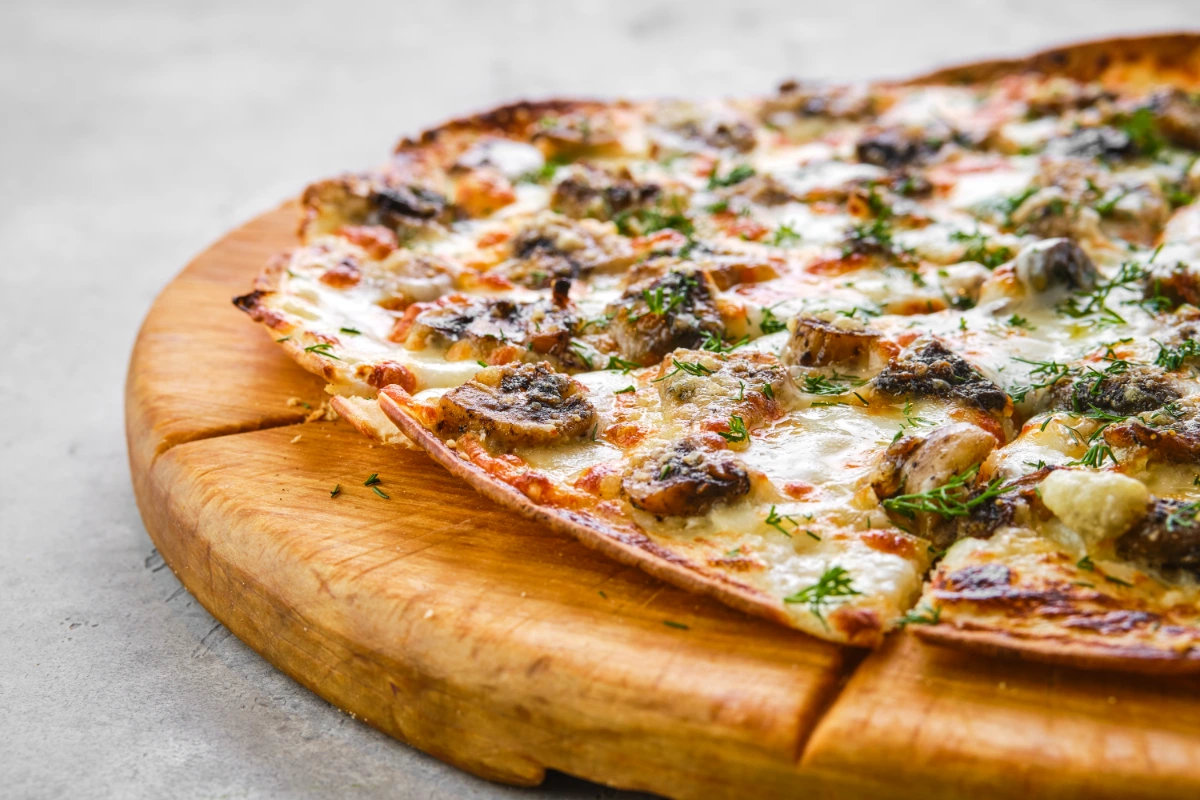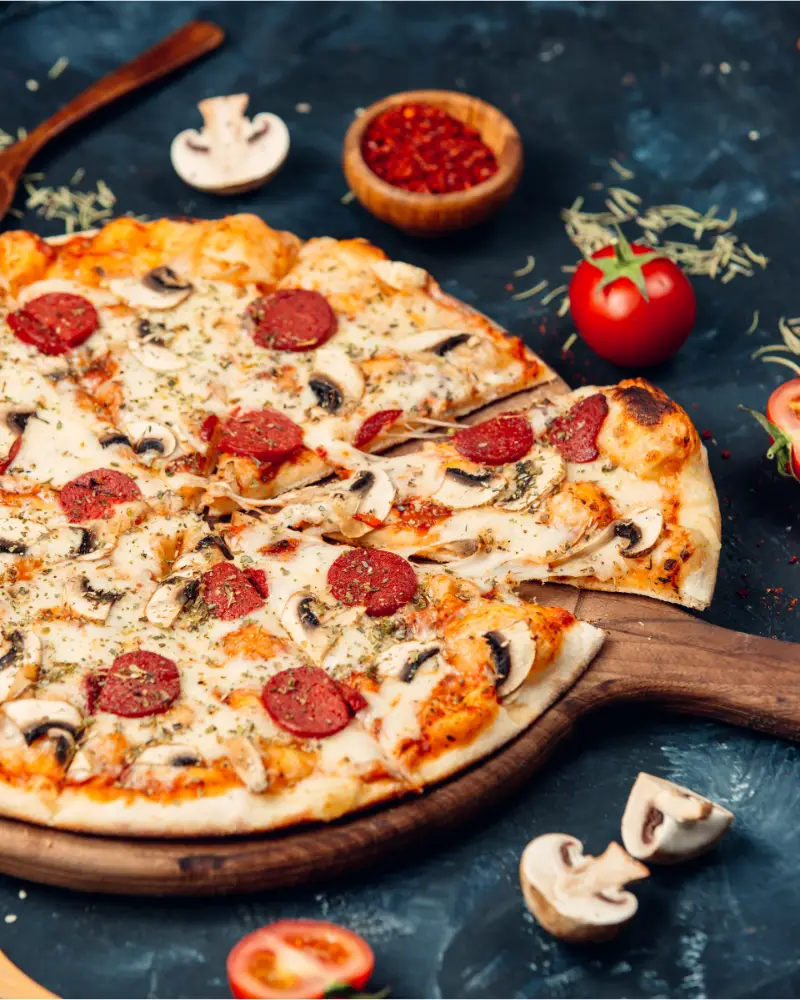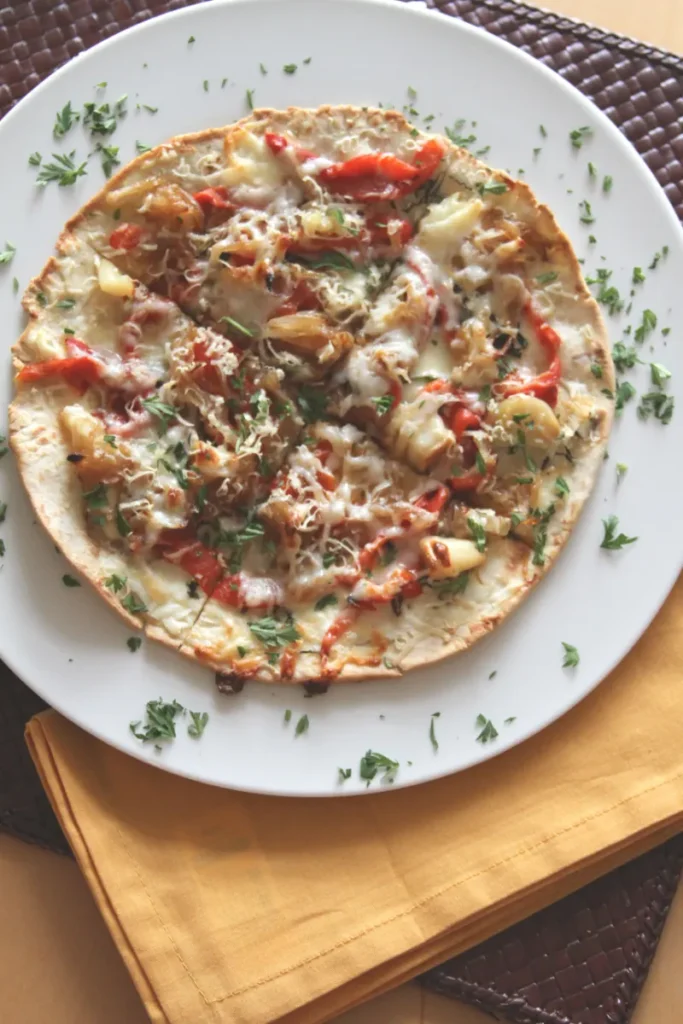Pizza, the beloved culinary creation, comes in countless forms, each with its own devoted following. Yet, one style consistently captures the hearts (and stomachs) of pizza enthusiasts worldwide: the thin crust pizza. This article delves into the world of thin crust, exploring its unique characteristics, the secrets behind its perfect preparation, and the endless possibilities for toppings and flavor combinations. So, whether you’re a seasoned pizzaiolo or a curious newcomer, get ready to embark on a delicious journey into the realm of thin crust pizza!
The Allure of Thin Crust Pizza
What is Thin Crust Pizza?
Ah, the thin crust pizza – a masterpiece of culinary balance. But what exactly defines this beloved style? Essentially, it’s all about the base – a thin, crispy crust that serves as the perfect canvas for an array of toppings. Unlike its thicker counterparts, thin crust pizza boasts a delicate structure, often with a slight charring on the edges, offering a satisfying crunch with every bite.
Of course, within the realm of thin crust pizza, regional variations abound. The iconic New York-style pizza, for instance, features a large, thin crust that’s foldable yet sturdy enough to hold a generous amount of toppings. Neapolitan pizza, hailing from Naples, Italy, boasts a thin, soft crust with a puffy, slightly charred edge, typically cooked in a wood-fired oven. Roman-style pizza, on the other hand, offers a rectangular shape and a cracker-like crust, perfect for those who prefer a crispier bite.
Why Choose Thin Crust?
With so many pizza styles available, why opt for thin crust? Well, for starters, it tends to be a healthier option. The thinner base means fewer carbs and less cheese, making it a lighter choice for the calorie-conscious. Additionally, the thinner crust allows the toppings to truly shine. Each flavor comes through without being overwhelmed by a thick, doughy base.
But let’s not forget the sheer pleasure of the eating experience! The crispy texture of thin crust pizza offers a delightful contrast to the soft, melted cheese and flavorful toppings. Each bite is a symphony of textures and tastes, making it a truly satisfying culinary adventure.
Making the Perfect Thin Crust Pizza
Essential Ingredients
Creating a delicious thin crust pizza begins with the right ingredients. Let’s explore the key players that contribute to a perfect base:
Flour Options
The type of flour you choose plays a crucial role in the texture and structure of your pizza dough. For a truly authentic Italian experience, 00 flour, finely ground Italian flour with low gluten content, is the gold standard. Its fine texture creates a light and airy dough that crisps up beautifully. However, if 00 flour isn’t readily available, all-purpose flour can be a suitable substitute. For those seeking a healthier option, whole wheat flour can be incorporated, though it may result in a slightly denser crust.
Yeast and Leavening Agents
Yeast is the magic ingredient that brings your thin crust pizza dough to life. Active dry yeast is commonly used, but instant yeast can also be a convenient option. Remember, the amount of yeast you use will influence the rising time, so be sure to follow the recipe instructions carefully. Additionally, some recipes may call for a touch of baking powder or baking soda to enhance the dough’s rise and texture.
Importance of Water and Hydration
Water is more than just a liquid in your pizza dough; it’s the key to achieving the perfect consistency. The right amount of hydration ensures a dough that’s pliable and easy to work with, while also contributing to the final texture of the crust. Be mindful of the water temperature, as lukewarm water activates the yeast, while cold water slows down the process.
Sauce – Classic Tomato or White Sauce Variations
The sauce serves as the flavorful foundation of your thin crust pizza. A classic tomato sauce, made with ripe tomatoes, herbs, and spices, is a timeless choice. However, don’t be afraid to explore other options like creamy white sauces, pesto-based sauces, or even barbecue sauce for a unique twist.
Dough Preparation Techniques
Now that you have your ingredients assembled, let’s dive into the art of dough preparation:
Mixing and Kneading
Whether you choose to mix your dough by hand or with a stand mixer, the goal is to achieve a smooth, elastic dough. Be patient and avoid overmixing, as this can lead to a tough crust. Kneading helps develop the gluten, giving the dough its structure and elasticity.
The Importance of Proper Dough Rising
Allowing your thin crust pizza dough to rise is crucial for both flavor and texture development. The rising time will depend on the type of yeast and the room temperature, so be sure to follow the recipe instructions. As the dough rises, the yeast ferments, creating air pockets that contribute to a light and airy crust.
Stretching and Shaping the Dough
Once your dough has risen, it’s time to stretch it into your desired shape. For thin crust pizza, aim for a thickness of about 1/4 inch. You can use a rolling pin or your hands to gently stretch the dough, being careful not to tear it.
Baking the Pizza
The final step in your thin crust pizza journey is baking it to perfection:
Achieving the Perfect Crispy Crust
A crispy crust is the hallmark of a great thin crust pizza. To achieve this, preheat your oven to a high temperature, ideally between 450-500°F (230-260°C). A pizza stone or steel can help distribute heat evenly and create a crispy base.
Oven Temperature and Baking Time Considerations
The baking time for your pizza will vary depending on the thickness of the crust and the toppings you choose. Generally, it takes about 10-15 minutes to bake a thin crust pizza until the crust is golden brown and the cheese is melted and bubbly.
Using a Pizza Stone or Steel
A pizza stone or steel is a worthwhile investment for any thin crust pizza enthusiast. These tools absorb and retain heat, creating an environment similar to a traditional wood-fired pizza oven. This results in a crispier crust and more even baking.
Topping Combinations and Inspiration
Classic Thin Crust Pizza Toppings
The beauty of thin crust pizza lies in its versatility. The possibilities for toppings are endless, but let’s start with some classic combinations that have stood the test of time:
Margherita Pizza – Simplicity at its best
- The Margherita pizza is a testament to the fact that sometimes, less is more. With its simple yet flavorful combination of fresh tomato sauce, mozzarella cheese, and basil leaves, it’s a true classic that allows the quality of the ingredients to shine.
Pepperoni – A timeless favorite
- Pepperoni pizza is a crowd-pleaser for a reason. The salty, spicy slices of pepperoni complement the tangy tomato sauce and gooey mozzarella cheese perfectly. It’s a classic combination that never goes out of style.
Veggie Delights – Options for vegetarian and vegan pizzas
- Thin crust pizza isn’t just for meat lovers. A variety of vegetables can be used to create delicious and satisfying vegetarian or vegan pizzas. Roasted peppers, onions, mushrooms, zucchini, and olives are just a few options to consider. For a vegan twist, use dairy-free cheese or explore creative alternatives like cashew cheese or nutritional yeast.
Gourmet and Creative Combinations
Once you’ve mastered the classics, it’s time to unleash your creativity and explore gourmet and unique topping combinations:
Exploring International Flavors
Why not take your taste buds on a global adventure? Draw inspiration from international cuisines to create unique thin crust pizzas. Consider a Thai-inspired pizza with peanut sauce, chicken, and vegetables, or a Mexican-inspired pizza with salsa, beans, and avocado. The options are limitless!
Using Seasonal and Fresh Ingredients
Take advantage of the freshest seasonal ingredients to elevate your pizza. In the summer, top your pizza with juicy tomatoes, zucchini, and fresh herbs. In the fall, embrace the flavors of roasted butternut squash, caramelized onions, and mushrooms.
Pairing Cheeses and Toppings for Unique Flavor Profiles
Don’t limit yourself to just mozzarella cheese. Experiment with different types of cheese to create unique flavor profiles. Gorgonzola adds a tangy bite, while goat cheese offers a creamy and slightly tart flavor. Consider the other toppings on your pizza and choose cheeses that complement their flavors.
FAQs About Thin Crust Pizza
Is thin crust pizza healthier than regular pizza?
Ah, the age-old question of health and pizza! While pizza, in general, isn’t typically considered a healthy food, thin crust pizza can indeed be a lighter option compared to its thick-crust counterparts. The thinner base naturally means fewer carbohydrates and less cheese, which translates to lower calorie and fat content.
However, it’s important to consider the toppings as well. Loading up your thin crust pizza with processed meats, extra cheese, and calorie-laden sauces can quickly negate its health benefits. Opting for vegetable-heavy toppings, lean protein sources, and a moderate amount of cheese can make your thin crust pizza a more balanced and nutritious choice.
What is the best flour for thin crust pizza dough?
The quest for the perfect thin crust pizza dough often leads to discussions about flour. As mentioned earlier, 00 flour is the go-to choice for many pizza enthusiasts, particularly for those seeking to replicate the authentic texture of Neapolitan-style pizza. Its fine grind and low gluten content create a dough that’s both easy to work with and bakes up beautifully crispy.
However, 00 flour may not always be readily available. In such cases, all-purpose flour can be a suitable substitute, though it may result in a slightly denser crust. For those who enjoy experimenting, bread flour, with its higher gluten content, can be used to create a chewier crust.
Can I make thin crust pizza without a pizza stone?
While a pizza stone undoubtedly enhances the baking experience and results in a crispier crust, it’s not an absolute necessity for making delicious thin crust pizza. If you don’t have a pizza stone, fear not! Here are a few alternative methods:
- Baking on a preheated baking sheet: Preheat your baking sheet in the oven while it heats up. This helps to create a hot surface for the pizza, promoting even browning and a crispier crust.
- Using a cast-iron skillet: A cast-iron skillet retains heat well and can be used to create a crispy crust. Preheat the skillet on the stovetop before transferring it to the oven.
What are some good toppings for a white pizza?
White pizzas, without the traditional tomato sauce base, offer a blank canvas for a variety of delicious toppings. Here are a few ideas to get you started:
- Classic White Pizza: Ricotta cheese, mozzarella cheese, garlic, and fresh herbs like oregano or thyme.
- Gourmet White Pizza: Fig jam, prosciutto, goat cheese, and arugula.
- Veggie White Pizza: Roasted vegetables like zucchini, peppers, and onions, with a sprinkle of Parmesan cheese.
Tips and Tricks for Thin Crust Pizza Perfection
Mastering the Dough
The foundation of a great thin crust pizza lies in the dough. Here are some tips to ensure your dough is a success:
- Measure accurately: Precision is key when it comes to baking. Use a kitchen scale for the most accurate measurements of flour and other ingredients.
- Don’t over-knead: While kneading is important for developing gluten, over-kneading can lead to a tough crust. Aim for a smooth and elastic dough that springs back when poked.
- Let it rise: Give your dough ample time to rise. This allows the yeast to do its magic, creating air pockets that contribute to a light and airy crust.
- Use the right flour: As discussed earlier, the type of flour you choose can significantly impact the texture of your crust. Experiment with different flours to find your preferred result.
Baking Like a Pro
The baking process is where your thin pizza truly comes to life. Here are some tips to achieve a crispy and delicious crust:
- Preheat your oven: A hot oven is crucial for creating a crispy crust. Preheat your oven to at least 450°F (230°C), or even higher if your oven allows.
- Use a pizza stone or steel: If you have one, a pizza stone or steel will help distribute heat evenly and create a superior crust. Preheat the stone or steel in the oven for at least 30 minutes before baking your pizza.
- Don’t overload with toppings: While it’s tempting to pile on the toppings, too much weight can make your thin crust pizza soggy. Stick to a moderate amount of toppings to ensure a crispy crust and even baking.
- Rotate the pizza: For even browning, rotate the pizza halfway through the baking process.
Getting Creative with Toppings
The world of thin crust pizza toppings is your oyster! Here are some ideas to spark your creativity:
- Think outside the box: Don’t be afraid to experiment with unconventional toppings. Explore international flavors, seasonal ingredients, and unique cheese combinations.
- Balance is key: Consider the flavors and textures of your toppings to create a harmonious pizza. Balance salty and sweet, acidic and creamy, and soft and crunchy elements.
- Less is often more: Remember, with thin crust pizza, the crust is the star of the show. Avoid overloading with toppings, as this can lead to a soggy crust and mask the flavors of the other ingredients.
With these tips and tricks, you’ll be well on your way to creating thin crust pizza masterpieces that will impress your taste buds and those you share them with.
Conclusion: A Toast to Thin Crust Perfection
From the initial allure of its crispy base to the endless possibilities of toppings, thin crust pizza has proven to be a culinary masterpiece. We’ve explored its origins, delved into the art of crafting the perfect dough, and embarked on a flavorful journey of topping combinations. Whether you’re a devoted fan or a curious newcomer, we hope this guide has ignited your passion for thin crust pizza.
So, gather your ingredients, preheat your oven (with a pizza stone if you have one!), and embark on your pizza-making adventure. With each creation, you’ll discover the joy and satisfaction of crafting a thin crust pizza that reflects your unique taste and preferences. Remember, the journey is just as important as the destination, so savor the process, experiment with flavors, and most importantly, enjoy every delicious bite!
More Delicious Recipes:
- Air fryer cinnamon rolls: Experience the joy of quick and easy Air Fryer Cinnamon Rolls. Perfect for busy mornings or sweet evening snacks, these fluffy rolls come out golden and delicious every time. Click here for the simple step-by-step recipe!
- Coffee flan: Indulge in the creamy, rich fusion of coffee and flan with our Coffee Flan recipe. This elegant, easy-to-make dessert is perfect for coffee enthusiasts and sweet tooths alike. Click here to learn how to make this impressive treat at home.
Coffee Flan: A Step-by-Step Recipe & Guide to Creamy Perfection




1 thought on “Thin Crust Pizza: The Ultimate Guide to Crispy Perfection”